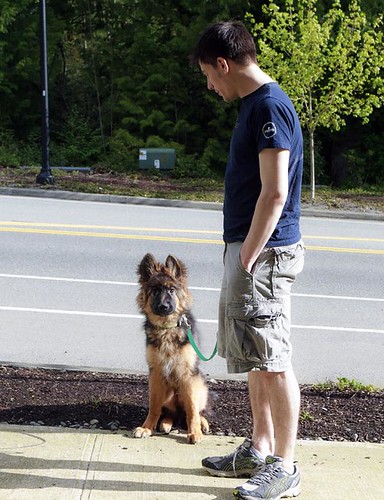[We] showed the video of [a suspect's] stop to two K-9 experts.
Gene Papet is executive director of K9 Resources, a company that trains detection dogs, including police dogs. Papet found a number of problems with the way [Officer] Reichert handled his dog. "Just before the dog alerts, you can hear a change in the tone of the handler's voice. That's troubling. I don't know anything about this particular handler, but that's often an indication of a handler that's cuing a response." In other words, it's indicative of a handler instructing the dog to alert, not waiting to see whether the dog will alert. "You also hear the handler say at one point that the dog alerted from the front of the car because the wind is blowing from the back of the car to the front, so the scent would have carried with the wind," Papet says. "But the dog was brought around the car twice. If that's the case, the dog should have alerted the first time he was brought to the front of the car. The dog only alerted the second time, which corresponded to what would be consistent with a vocal cue from the handler."
Russ Jones is a former police officer with 10 years in drug enforcement, including as a K-9 officer. He's now a member of Law Enforcement Against Prohibition, a group of current and former cops and prosecutors who favor ending the war on drugs. "That dog was going to do what ever (Officer Reichert) needed it to do," Jones says. "Throughout the video, the dog is looking for handler feedback, which isn't how it's supposed to work."
In the 2005 case Illinois v. Caballes, the US Supreme Court ruled that having a drug dog sniff the exterior of a vehicle during a routine traffic stop does not violate the Fourth Amendment. But in a dissent to that opinion, Justice David Souter pointed to mounting evidence that drug dogs aren't as infallible as police departments often claim. Souter noted a study that the state of Illinois itself used in its briefs, showing that in lab tests, drug dogs fail 12.5% - 60% of the time. Since then,
more evidence has emerged to support Souter's concerns.
The problem isn't that the dogs aren't capable of picking up the scent, it's that dogs have been bred to please and interact with humans. A dog can easily be manipulated to alert whenever needed. But even with conscientious cops, a dog without the proper training may pick up on its handler's body language and alert whenever it detects its handler is suspicious.
In
one study published last year in the journal Animal Cognition, researchers rigged some tests designed to fool dogs into falsely alerting and others designed to trick handlers into thinking a package contained narcotics (it didn't). Of the 144 total searches performed, the dogs falsely alerted 123 times. More interesting, the dogs were twice as likely to falsely alert to packages designed to trick their handlers than those designed to trick the dogs.
In 2011, the Chicago Tribune
published a review of drug dog searches conducted over three years by police departments in the Chicago suburbs. The paper found that just 44% of dog "alerts" led to the discovery of actual contraband. Interestingly, for Hispanic drivers the success rate dipped to 27%, again supporting the theory that drug dogs tend to confirm the suspicions (and, consequently, the biases) of their handlers.
A 2006
statistical analysis of police dog tests by University of North Carolina law professor Richard Myers concluded that the dogs aren't reliable enough to provide probable cause for a search.
[We] obtained the records for one Illinois state police K-9 unit for an 11-month period in 2007 and 2008. Of the 136 times this particular dog alerted to the presence of drugs during a traffic stop over that period, 35 of the subsequent hand searches found measurable quantities of illegal drugs.
See accompanying article for a more thorough analysis of the K-9 records:
An analysis of the K9 records shows that only 25.7% of the drug dog's "alerts" resulted in police finding a measurable quantity of illicit drugs. Just 13% resulted in the recovery of more than 10 grams of marijuana, generally considered an amount for personal use, and 10.4% turned up enough drugs to charge the motorists or their passengers with at least one felony.
Jones, the former narcotics and K-9 officer, said those sorts of numbers are why he now opposes the drug war. "90% of these dog-handler teams are utter failures. They're just ways to get around the Fourth Amendment," he says. "When I debate these people around the country, I always challenge the K-9 officers to a double-blind test to see how accurate they and their dogs really are. They always refuse."
These figures strongly suggest that while the Supreme Court has ruled that there's nothing invasive about an exterior drug dog sniff of a car, in truth, the dog’s alert may be nothing more than the dog confirming its handler's hunches--which is exactly what the Fourth Amendment is supposed to protect against.

 They gave him sedatives every day.
They gave him sedatives every day. , but I always find this sort of pre-photographic documentation of breed development pretty cool.
, but I always find this sort of pre-photographic documentation of breed development pretty cool.




 What a sweet portrait of her.
What a sweet portrait of her. .
.

